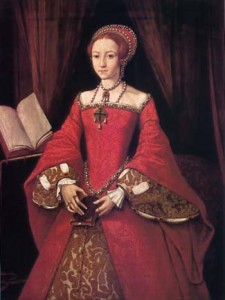Today’s addition is a guest post written by Maggie Secara author of ‘A Compendium of Common Knowledge 1558-1603: Elizabethan Commonplaces for Writers, Actors and Re-enactors.’
Maggie also runs Renaissance: The Elizabethan World, a fabulous website overflowing with information about life in Elizabeth’s England.
Maggie’s post is essentially a compendium page focussing on some interesting facts about Elizabeth I’s royal childhood.
Enjoy!
A Queen’s Childhood
by Maggie Secara
She was a princess, and so her upbringing was never going to be like other children’s.
Born in a fancy bed brought out of the king’s jewel house.
Anne’s servants during her confinement were entirely women, even those offices who would ordinarily have been men, like her steward, pages, chamberers, etc. Palace guards (male) stood only at the outermost doors to her apartments, charged to let no man enter except the king and his physicians.
She was baptized according to custom at 3 days old.
Up to the day of the christening she was going to be called Mary, to completely supplant her half-sister. At the last minute, Henry changed his mind and went for his mother’s name, Elizabeth, instead.
The princess Mary was 17 at the time of Elizabeth’s birth. They took away her servants and household and forced her to wait on the baby. She fought against the insult as long as she could, but finally gave in. She took on every required service first reciting a set formula registering her objection, and making it clear she was doing it under protest.
Her mother was executed just before Elizabeth was 3 years old.
When no longer Princess of Wales, she was variously addressed and referred to as the lady Elizabeth or Madam Elizabeth.
The succession of step-mothers was not that unusual, just the method of their coming and going.
“We knew if he gave her a hat she’d probably be all right!”
Blackadder’s Christmas Carol, 1988
The standard mourning period even for a spouse was only 30 days, so Henry wasn’t rushing into anything or going against custom by immediately taking a new wife. Dressing in happy colors and doing a jig when he got the news of his wife’s death was a bit much, even to contemporaries.
Elizabeth was in and out of bastardy, according to the king’s needs. Finally included with Mary in the Act of Succession.
He showed her off to the various ambassadors and negotiated for her marriage even before she could walk.
Having declared her illegitimate, however, the king essentially made her unmarriageable to any royal prince.
Those who called Anne Boleyn “The Great Whore” happily referred to her baby daughter as the “Little Whore”. Whore in this case means morally bankrupt, not merely sexually available or opportunistic.
As the child grew, these same people said they could see the features of Mark Smeaton in her face. Smeaton was the musician who confessed under torture to having had carnal knowledge of Queen Anne. Henry may have bastardized her but never doubted she was his red-haired child.
She was brought up away from her parents, as were other royal children, though they occasionally visited or had her brought to them, played with her, and left. All three children had separate establishments until Elizabeth was brought to study with her brother.
Henry’s health was not what it had been, his legs pained him, and his temper was more prickly than it had been in his youth. He was certainly tall and loud, if not exactly the bluff King Hal of old. He must have been a huge, terrifying stranger.
Lady Margaret Bryan, who had been lady governess to Princess Mary was moved to Elizabeth’s service. Her job was essentially that of a nanny and thus head of her household.
Shortly after Anne’s death, Lady Bryan wrote to the king basically begging for money and supplies. The lady Elizabeth had outgrown all the little gowns and caps and everything else that had last been ordered for her and no provision had been made for more.
When Prince Edward was born, Lady Bryan went to run his household and was replaced by Lady Troy until she retired, when Katherine Champerknown, eventually Ashley or Astley, came in as her waiting gentlewoman and governess. Except for occasions when she was imprisoned in the Fleet (once for conspiring to help the Lady Elizabeth to a marriage with Thomas Seymour), she stayed in Elizabeth’s service until Kat’s death in 1565.
Kat may have given Elizabeth her first lessons in astronomy, geography, history, mathematics, and possibly in French, Flemish, Italian and Spanish.
By the age of 5 or 6, Elizabeth had begun to learn Latin which came very easily to her. A precocious student, she was essentially given a boy’s education.
Began studying with her brother and his tutors when she was about 10, followed by a series of excellent tutors of her own, especially John Cheke, who taught her Greek, and Roger Ascham.
Most of these studies were undertaken under the guidance of her step-mother Queen Catherine (Parr) in her house in Chelsea.
Also in the house were Jane Dormer and other bright and noble girls considered appropriate for her to keep company with. A contemporary called the house “a school of virtue for learned virgins.”
Parents had virtually godlike authority over their children. Filial piety was also among her earliest lessons. One report says she was seen to sink to her knees three separate times during a single interview with her father.
Sources:
Carolly Erickson, The First Elizabeth
Neville Willliams, The Life and Times of Elizabeth I
Carolly Erickson, Mistress Anne: The Exceptional Life of Anne Boleyn
















Latest Comments